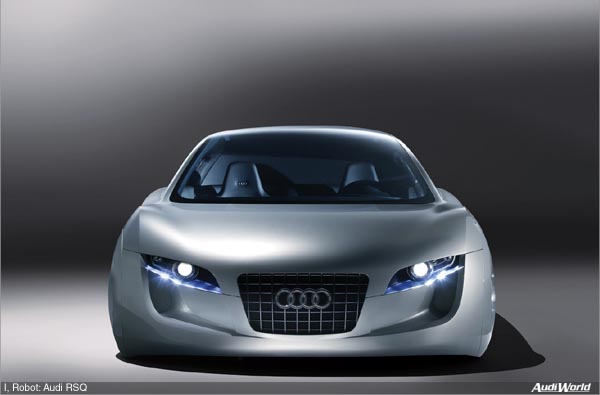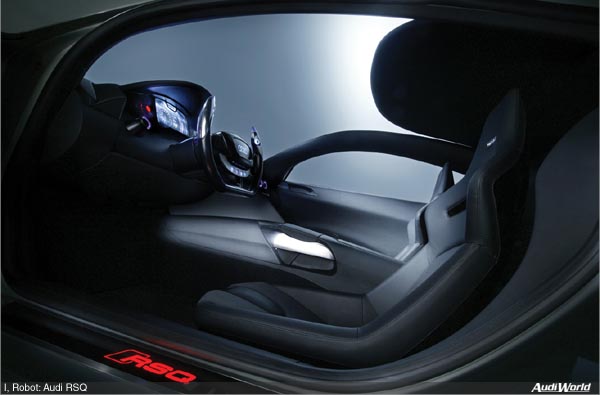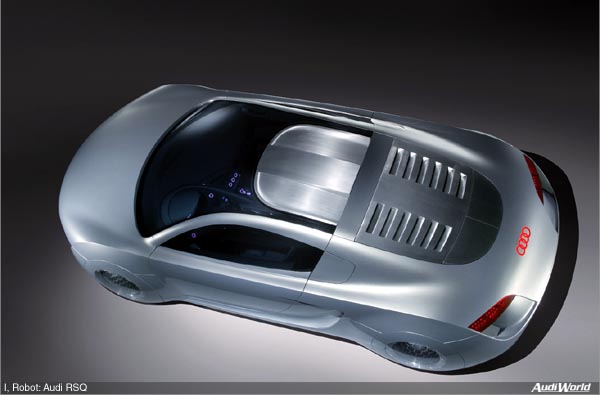Great enthusiasm and a professional approach marked the cooperation between car manufacturer and movie maker
Development of a production car is obviously the job of a designer. Being able to work free from technical requirements is the dream of all automobile designers. Having a chance to integrate his or her creative potential into the development and construction of a futuristic sports coupe, to be driven by a Hollywood star in a blockbuster movie event – what could be more exciting for a designer?
Consequently there was great enthusiasm when Audi Design was awarded the contract to develop a vehicle called the Audi RSQ for the motion picture “I, ROBOT” starring Hollywood celebrity Will Smith – the first car ever built by the German premium automobile manufacturer especially for a motion picture.
Film director Alex Proyas was attracted by the Audi Nuvolari quattro concept car in 2003. He liked the design language of the brand with the four rings so much that he decided to contact Audi. In early April 2003 Tim Miksche, AUDI AG’s manager responsible for Product Placement, and Martin Ertl, Head of Audi Design Management, flew to Vancouver, Canada, where preparations for shooting were under way. “The director, producers, the set designer, the chief camera man and Twentieth Century Fox representatives showed us around to see the entire movie world of “I, ROBOT” – everything from giant stage settings to a humble wrist watch,” Miksche recalls. This was the world which the car had to fit into.
Twenty-four hours later they had reached agreement: Audi had won the contract despite bids by other automobile manufacturers. This was achieved by presenting a convincing overall vehicle concept. “When we took off from Munich airport everything was up in the air. But when we returned home a day later, we had in our briefcases the biggest product placement project in Audi’s corporate history – and a lot of work on our plate,” Miksche remembers.
There was no time to lie back and rest. Only two days later the first quarter-scale model of the RSQ was completed. A set designer of “I, ROBOT” travelled to Ingolstadt to carry out fine tuning within one week in cooperation with Audi Design. “After that”, says Martin Ertl, “the major part of design and vehicle specifications were finalized.” Four weeks later a second meeting was held in Ingolstadt to discuss the technical details.
The construction time was at least as fast as the Audi RSQ itself – designers, engineers, technicians and model engineers had just ten weeks to build the concept car. At the beginning of July the Audi RSQ arrived on the set in Vancouver where it was to stay for several months of shooting. Audi also supplied an outer-skin model of the car to be used in a crash scene, as well as a separate interior mock-up to shoot interior scenes. The project took to its wheels – or spheres to be more precise – right in time.

It is 2035 in Chicago, and cars no longer travel on wheels but on spheres. “Integrating these spheres into the car’s design was one of the greatest challenges we had to solve”, says Julian Hönig, responsible for the RSQ’s exterior design. The result was a two-seat, mid-engined sports car with sphere-shaped wheels running in similarly shaped wheel arches. Hönig said. “This even enhanced the car’s sculptured character.”
It is a sculpture that appears very flat, broad and bullish on the road. The laminate glass fiber body of the RSQ is coated with lunar silver paint, which creates the so-called flop effect. That is to say: when exposed to intensive light the bluish sheen of the silver paint takes on a golden tone.
“In this project we enjoyed the greatest possible freedom with regard to technical feasibility, ergonomics and customer requirements – factors that otherwise have high priority. First of all we had to familiarize ourselves with the special vehicle specifications required by the story and the movie’s environment. The main aim was to create a car that both plausibly fit into the futuristic scenery of the film, but still represented an unmistakable, visionary statement from Audi”, says Julian Hönig. Altogether, four Audi designers and as many as ten model engineers from an external Audi partner were involved in the project.
The striking shape of the angular body cutouts for the head-light modules influence the front-end appearance of the RSQ. They are combined with side air inlets. The xenon light tubes behind the clear-glass covers enhance the character of the front-end design.
Where you find the rear window on most sports coupes, an aluminium hood covers the engine in the RSQ. In plain view this cover is an oval, running right up to the windscreen and integrated into the body by a transverse bar.
The gull-wing doors are another RSQ highlight: whenever Will Smith gets into or out of the car, the rear-hinged doors open upwards like a butterfly’s wings, and twist slightly at the same time.
The interior of the RSQ was reduced to the essential elements of driving. Will Smith sits in the car as if in a jet aircraft’s cockpit. The center console surrounds the “pilot’s” body in the bucket seat.

The steering wheel is another element in this aircraft cockpit analogy. Like an elevator control, it is open at the top and folds out of the instrument panel after the driver has entered the car.
The cockpit atmosphere of the interior is emphasized by the wide panoramic windscreen that extends back into the roof. The glass surface runs from the right and left roof pillars as far as the rear of the cabin. This ensures a much greater field of view for the driver and passenger.
All relevant information for driving the car is fed into the digital display in the instrument cluster by means of Audi’s Multi Media Interface (MMI) control system. The air conditioning and radio of the RSQ are classified as secondary functions. Entertainment functions have been omitted in favor of the sporting concept.
The materials used and the colors of the RSQ interior are part of a function-oriented spatial atmosphere. The color spectrum is exclusively in the darker, more `technical’ appearance area with isolated silvery accents. RSQ lettering illuminated with red light is integrated into the door sills. Workmanship and materials are of top quality – a typical Audi feature.
Despite its futuristic appearance the RSQ still had to be clearly recognizable as an Audi. Walter de’Silva, Head of Design for the Audi brand group, told his creative team: “You have the freedom to use the craziest ideas, but don’t forget the features that identify our brand.” The nose end of the film car was therefore designed to yield a typical Audi family resemblance. The trapezoidal shape of the Audi single-frame grille was adjusted to suit the proportions of the sports coupe.
“I believe that the Audi RSQ is a possible vision for the future, embedded in a fictional world. It is the consistent further development of brand values such as sportiness, progressiveness and sophisticated design, transferred to the film world of `I, ROBOT’.” De ‘Silva concludes “an Audi of the future could therefore look much the same …”.

